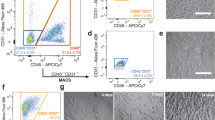Abstract
The ultrastructural and immunocytochemical characteristics of microvascular cells from human subcutaneous fat tissue were studied after the addition of collagenase and Percoll density gradient, respectively. Monoclonal and polyclonal antibodies directed against antigens specific for endothelial cells (factor VIII,Ulex europeaus, CD31, and CD34), pericytes (muscle-specific actin and desmin), adipocytes (S-100 protein), and monocytes-macrophages (MAC 387 and 150.95 protein) were demonstrated by alkaline phosphatase monoclonal antialkaline phosphatase and protein A-gold techniques. In addition, to determine whether the harvesting method interfered with microvascular cell function, DOT immunoassays of factor VIII and CD34 were conducted on solutions recovered at collagenase incubation as well as after nylon filtration and Percoll administration, respectively. After the collagenase step, the vast majority of microvascular cells had the typical ultrastructural and immunophenotypical features of endothelial cells. In sharp contrast, following the Percoll step, only 1% to 18% of microvascular cells stained with factor VIII,Ulex europeaus, and CD31, whereas 90% of them expressed the CD34 antigen. Surprisingly, DOT immunoassay revealed the presence of factor VIII in the washing buffer recovered after the Percoll step only. Consequently the decreased expression of common endothelial cell markers (factor VIII,Ulex europaeus, and CD31) observed at the end of the cell isolation procedure was related to the adverse effects of Percoll on endothelial cell function. The CD34 surface molecule, being highly resistant, is particularly well suited for unequivocal characterization of microvascular cells as true endothelium.
Similar content being viewed by others
References
Jarrel BE, Williams SK, Hoch J, et al. Rapidly established endothelial cell monolayers. In Zilla PP, Fasol RD, Deutsch M, eds. Endothelialization of Vascular Grafts. Basel: Karger, 1987, pp 145–159.
Williams SK, Jarrell BE, Rose DG. Isolation of human fat-derived microvessel endothelial cells for use in vascular graft endothelialization. In Zilla PP, Fasol RD, Deutsch M, eds. Endothelialization of Vascular Grafts. Basel: Karger, 1987, pp 211–217.
Stansby G, Fuller B, Hamilton G. Human omental microvascular endothelial cells: Are they endothelial? In Zilla PP, Fasol RD, Callow A, eds. Applied Cardiovascular Biology 1990–1991, vol 2. Basel: Karger, 1992, pp 120–123.
Meerbaum SO, Sharp WV, Schmidt SP. Lower extremity revascularization with polytetrafluoroethylene grafts seeded with microvascular endothelial cells. In Zilla PP, Fasol RD, Callow A, eds. Applied Cardiovascular Biology 1990–1991, vol 2. Basel: Karger, 1992, pp 107–119.
Curti T, Pasquinelli G, Preda P, et al. An ultrastructural and immunocytochemical analysis of human endothelial cell adhesion on coated vascular grafts. Ann Vasc Surg 1989;3:351–363.
Pasquinelli G, Preda P, Vici M, et al. Development of a rotation device for endothelial cell seeding. Cells Materials 1992;4:291–297.
Cordell JL, Falini B, Erber WN, et al. Immuno-enzymatic labeling of monoclonal antibodies using immune complexes of alkaline phosphatase and monoclonal antialkaline phosphatase (APAAP complexes). J Histochem Cytochem 1984;32:219–229.
Frens G. Controlled nucleation for the regulation of the particle size in monodisperse gold solution. Nature Phys Sci 1973;241:20–22.
Roth J, Bendayan M, Orci L. Ultrastructural localization of intracellular antigens by the use of protein A-gold complexes. J Histochem Cytochem 1978;26:1077–1081.
Musiani M, Zerbini M, Gentilomi G, et al. An amplified DOT immunoassay for the direct quantitation of adapted and wild strains of human cytomegalovirus. J Virol Methods 1989;24:327–334.
Erlandson RA. Diagnostic immunohistochemistry of human tumors. An interim evaluation. Am J Surg Pathol 1984;8:615–624.
Civin CI, Strauss LC, Brovall C, et al. Antigenic analysis of hematopoiesis. III. A hematopoietic progenitor cell surface antigen defined by a monoclonal antibody raised against KG-1a cells. J Immunol 1984;133:157–165.
Fina L, Molgaard HV, Robertson D, et al. Expression of the CD34 gene in vascular endothelial cells. Blood 1990;75:2417–2426.
Nickoloff BJ. The human progenitor cell antigen (CD34) is localized on endothelial cells, and perifollicular cells in formalin-fixed normal skin, and on proliferating endothelial cells and stromal spindle-shaped cells in Kaposi's sarcoma. Arch Dermatol 1991;127:523–529.
Watt SM, Karhi K, Gatter K, et al. Distribution and epitope analysis of the cell membrane glycoprotein (HPCA-1) associated with human hemopoietic progenitor cells. Leukemia 1987;1:417–426.
Author information
Authors and Affiliations
About this article
Cite this article
Vici, M., Pasquinelli, G., Preda, P. et al. Electron microscopic and immunocytochemical profiles of human subcutaneous fat tissue microvascular endothelial cells. Annals of Vascular Surgery 7, 541–548 (1993). https://doi.org/10.1007/BF02000148
Issue Date:
DOI: https://doi.org/10.1007/BF02000148




